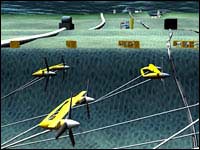In Washington recently, Secretary of the Interior Dirk Kempthorne made an announcement that clears the way for a new and largely untapped renewable energy resource — the oceans.
He announced regulations that would "guide the use of wind, wave and current resources on the 1.8 billion acres of Outer Continental Shelf on the coasts of the Atlantic, Pacific and Gulf Coast."
In South Florida, researchers are already working to harness the power of one of the ocean's most energy-dense currents — the Gulf Stream.
The Center of Excellence in Ocean Energy Technology is only a little more than a year old, but it's in a great location. It's just off the beach and, as director Rick Driscoll points out on a map, it is just 15 miles from the Gulf Stream.
"This is actually the closest location of any place on the planet of a major ocean current by a load center that needs the power now," he says. "We have no place to build power plants and yet we're growing. Florida is growing by a thousand people a day."
8 Billion Gallons Per Minute
Driscoll's answer: underwater turbines moored in the heart of the Gulf Stream. He believes that ultimately, the current — which flows at 8 billion gallons per minute — could yield as much energy as several nuclear plants, providing one-third of Florida's power.
Florida Atlantic University established the center last year for one purpose: to explore ways to tap the ocean's potential as a renewable energy resource. It was started with a $5 million grant from the state of Florida.
Inside, the center's offices and workshop area share a common space. Desks and cubicles sit alongside scientific equipment, giant floats, and what looks like a large propeller. It's 10 feet in diameter, but as turbine rotors go, that's actually quite small, Driscoll says.
The full-sized turbines will be much larger — with rotors 100 feet in diameter.
This rotor is for the small prototype Driscoll and his team are building. Pieces of it — the generator, pressure tank and housing — are laid out on the floor. It's nearly ready for testing.
The 'Cuisinart Effect'
Driscoll eventually envisions a field of turbines moored 1,000 feet below the surface, just off the Florida coast in the heart of the Gulf Stream. Dozens of energy companies are developing plans to harness the Gulf Stream, he says. The researchers at the Center of Excellence in Ocean Energy Technology are studying the best ways to do it and looking for possible negative consequences.
"Some of the worst-case things we can see is what people have coined the 'Cuisinart effect' in which fish come through and get chopped up," Driscoll says. "The bait would then attract more fish and you've got a sustaining Cuisinart effect. We don't think that's going to happen, but it's a possibility, and we need to monitor it."
Driscoll says his team is also looking to see what effect the turbines could possibly have on the power and flow of the Gulf Stream. He cites hydrographic data reassuringly, and says it looks unlikely that it will have much of an impact. And even the most optimistic researchers don't hope to extract more than one-third of the Gulf Stream's total energy.
A few steps outside, welders are working on one of the most massive parts of the Gulf Stream turbine. It's a huge steel buoy that, as project director Gabriel Alsenas points out, is shaped like a ship so it remains stable in the current.
The buoy is part of a system — tethered to a 30,000-pound anchor — that Alsenas says will hold the prototype turbine right in the heart of the Gulf Stream. The turbine will be about 30 feet under water, spinning approximately 60 revolutions per minute, he says.
"This gives us a great exercise in figuring out exactly what effects the ocean's going to have on it and what effect this is going to have on the ocean and its environment," Alsenas says.

